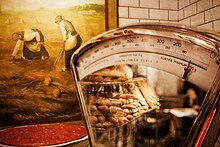
Back Lyonská kuchyně Czech Lyoneser Küche German Cuisine lyonnaise French Cucina lionese Italian Gastronomia Lugdunensis Latin
This article includes a list of general references, but it lacks sufficient corresponding inline citations. (August 2013) |
You can help expand this article with text translated from the corresponding article in French. (September 2013) Click [show] for important translation instructions.
|

Lyonnaise cuisine refers to cooking traditions and practices centering on the area around the French city of Lyon[1] and historical Lyonnais culinary traditions.
In the 16th century, Catherine de Medici brought cooks from Florence to her court and they prepared dishes from agricultural products from many regions of France. This was revolutionary, as it combined the fresh, diverse and indigenous nature of regional produce with the know-how of Florentine cooks.
The result was that regional specialities were elevated in status among royalty and nobility. Lyonnaise cuisine became a crossroads of many regional culinary traditions. A surprising variety of ingredients from many nearby places emerged: summer vegetables from farms in Bresse and Charolais, game from the Dombes, lake fish from Savoy, spring fruits and vegetables from Drôme and Ardèche, and wines from Beaujolais and the Rhone Valley.
In the 19th century, middle-class women, nicknamed the "Lyonnaise mothers", left their homes to work as cooks and created brand new culinary traditions incorporating their regional roots.
In 1935, the food critic Curnonsky described the city of Lyon as the "world capital of gastronomy".
In the 21st century, Lyon's cuisine is defined by simplicity and quality, and is exported to other parts of France and abroad. With more than a thousand eateries, the city of Lyon has one of the highest concentrations of restaurants per capita in France.
- ^ Kindersley, Dorling (2011). Ultimate Food Journeys: The World's Best Dishes and Where to Eat Them. Penguin. p. 49. ISBN 0756695880